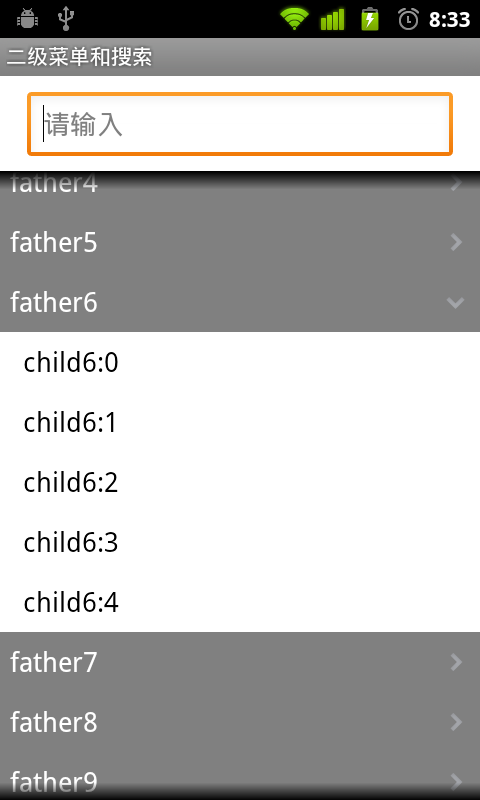
- Android 数据存储方式有哪几种
- android游戏载入的activity跳转到游戏主菜单的activity具体实现
- Android AlertDialog实现分享对话框/退出对话框/下载对话框
- Android矢量图之VectorDrawable类自由填充色彩
- 浅析Android手机卫士之抖动输入框和手机震动
- Android SharedPreferences的使用分析
- Android WebView使用方法详解 附js交互调用方法
- Android开发中Activity属性设置小结
- Android中ListView下拉刷新的实现方法实例分析
- Android实现三级联动下拉框 下拉列表spinner的实例代码
- Android文件下载进度条的实现代码
- Android自定义圆角ImageView
- 基于Android Service 生命周期的详细介绍
- Android开发之App widget用法实例分析
- Android应用开发中自定义ViewGroup的究极攻略
- Android利用Camera实现中轴3D卡牌翻转效果
- 完美解决EditText和ScrollView的滚动冲突(上)
- Android模拟器对应的电脑快捷键说明
- android使用多线程更新ui示例分享
- Android App中ViewPager与Fragment结合的一些问题解决
- 深入Android 五大布局对象的应用
- Android布局之RelativeLayout相对布局
- 四种Android数据存储方式
- Android CheckBox 的使用案例分析
- android开机自启动原理与实现案例(附源码)
- Android客户端软件开发_15、下载模块界面分析和实现
- Android仿微信底部实现Tab选项卡切换效果
- Android自定义控件实现边缘凹凸的卡劵效果
- Android 屏幕双击事件的捕获简单示例
- Android中执行java命令的方法及java代码执行并解析shell命令
Android编程实现二级下拉菜单及快速搜索的方法
作者:佚名 Android开发编辑:admin 更新时间:2022-07-23
本文实例讲述了Android编程实现二级下拉菜单及快速搜索的方法。分享给大家供大家参考,具体如下:
一、我们要做什么?

上面有个搜索框,下面是一个二级下拉菜单。

输入查询内容,下面列表将显示查询结果。
二、界面设计
(1)这是主框架(部分属性已经省去,请看源码),从上至下分别是文本框,列表,二级列表。
<?xml version="1.0" encoding="utf-8"?> <LinearLayout> <LinearLayout android:id="@+id/city_middle"> <EditText android:id="@+id/txtfind" android:hint="请输入" > </EditText> <ListView android:id="@+id/listfind" > </ListView> <ExpandableListView android:id="@+id/exList" /> </LinearLayout> </LinearLayout>
(2)一级菜单栏样式,图片将区别是否展开
<?xml version="1.0" encoding="utf-8"?> <LinearLayout > <TextView android:id="@+id/group" > </TextView> <ImageView android:id="@+id/tubiao"> </ImageView> </LinearLayout>
(3)二级菜单栏样式
<?xml version="1.0" encoding="utf-8"?> <LinearLayout > <TextView android:id="@+id/child"> </TextView> </LinearLayout>
三、代码设计
(1) 定义菜单对应数据
public static List<BasicNameValuePair> fatherList = new ArrayList<BasicNameValuePair>(); public static List<List<BasicNameValuePair>> childList = new ArrayList<List<BasicNameValuePair>>();
生成测试数据
for (int i = 0; i < 20; i++) {
fatherList.add(new BasicNameValuePair("father" + i, "father" + i));
List<BasicNameValuePair> cList = new ArrayList<BasicNameValuePair>();
for (int j = 0; j < 5; j++) {
cList.add(new BasicNameValuePair("child" + i + ":" + j, "child"
+ i + ":" + j));
}
childList.add(cList);
}
(2)定义列表适配器
protected class ListAdapter extends BaseAdapter {
private LayoutInflater mInflater;
//查询结果列表
private List<BasicNameValuePair> list = new ArrayList<BasicNameValuePair>();
public ListAdapter(Context context, String strin) {
mInflater = LayoutInflater.from(context);
//查询匹配
for (int i = 0; i < childList.size(); i++) {
for (int j = 0; j < childList.get(i).size(); j++) {
String tmp = childList.get(i).get(j).getValue();
if (tmp.indexOf(strin) >= 0) {
list.add(new BasicNameValuePair(childList.get(i).get(j)
.getName(), tmp));
}
}
}
}
public int getCount() {
return list.size();
}
public Object getItem(int position) {
return position;
}
public long getItemId(int position) {
return position;
}
public View getView(final int position, View convertView,
ViewGroup parent) {
convertView = mInflater.inflate(R.layout.child, null);
TextView title = (TextView) convertView.findViewById(R.id.child);
title.setText(list.get(position).getValue());
return convertView;
}
}
初始化列表,默认为隐藏
list = (ListView) findViewById(R.id.listfind); list.setVisibility(View.GONE);
(3)定义二级列表适配器
protected class ExAdapter extends BaseExpandableListAdapter {
@Override
public int getGroupCount() {
return fatherList.size();
}
@Override
public int getChildrenCount(int groupPosition) {
return childList.get(groupPosition).size();
}
@Override
public Object getGroup(int groupPosition) {
return fatherList.get(groupPosition).getValue();
}
@Override
public Object getChild(int groupPosition, int childPosition) {
return childList.get(groupPosition).get(childPosition).getValue();
}
@Override
public long getGroupId(int groupPosition) {
return groupPosition;
}
@Override
public long getChildId(int groupPosition, int childPosition) {
return childPosition;
}
@Override
public View getGroupView(int groupPosition, boolean isExpanded,
View convertView, ViewGroup parent) {
View view = convertView;
if (view == null) {
LayoutInflater inflater = (LayoutInflater) getSystemService(Context.LAYOUT_INFLATER_SERVICE);
view = inflater.inflate(R.layout.group, null);
}
TextView t = (TextView) view.findViewById(R.id.group);
t.setText(fatherList.get(groupPosition).getValue());
//展开,改变图片
ImageView gImg = (ImageView) view.findViewById(R.id.tubiao);
if (isExpanded)
gImg.setBackgroundResource(R.drawable.mm_submenu_down_normal);
else
gImg.setBackgroundResource(R.drawable.mm_submenu_normal);
return view;
}
@Override
public View getChildView(int groupPosition, int childPosition,
boolean isLastChild, View convertView, ViewGroup parent) {
View view = convertView;
if (view == null) {
LayoutInflater inflater = (LayoutInflater) getSystemService(Context.LAYOUT_INFLATER_SERVICE);
view = inflater.inflate(R.layout.child, null);
}
TextView t = (TextView) view.findViewById(R.id.child);
t.setText(childList.get(groupPosition).get(childPosition)
.getValue());
return view;
}
@Override
public boolean hasStableIds() {
return true;
}
@Override
public boolean isChildSelectable(int groupPosition, int childPosition) {
return true;
}
}
初始化二级菜单
exList = (ExpandableListView) findViewById(R.id.exList); exList.setAdapter(new ExAdapter()); exList.setGroupIndicator(null); exList.setDivider(null);
(4)搜索事件,输入改变即触发
txtFind = (EditText) findViewById(R.id.txtfind);
txtFind.addTextChangedListener(new TextWatcher() {
@Override
public void beforeTextChanged(CharSequence s, int start, int count,
int after) {
}
@Override
public void onTextChanged(CharSequence s, int start, int before,
int count) {
}
@Override
public void afterTextChanged(Editable s) {
if (s != null && !s.toString().equals("")) {
list.setAdapter(new ListAdapter(DWinterDemoActivity.this, s
.toString()));
list.setVisibility(View.VISIBLE);
exList.setVisibility(View.GONE);
} else {
list.setVisibility(View.GONE);
exList.setVisibility(View.VISIBLE);
}
}
});
(5)去除焦点自动弹出输入
getWindow().setSoftInputMode( WindowManager.LayoutParams.SOFT_INPUT_STATE_ALWAYS_HIDDEN);
希望本文所述对大家Android程序设计有所帮助。
- 上一篇文章: android编程实现为程序创建快捷方式的方法
- 下一篇文章: Android编程实现图片的浏览、缩放、拖动和自动居中效果
- Android 解析JSON对象及实例说明
- Android编程中Perferences的用法实例分析
- android从系统图库中取图片的实例代码
- 细数Android移动系统6年演变10次重大更新
- android短信拦截的实现代码
- Android实现动画效果详解
- 浅析Android手机卫士自定义控件的属性